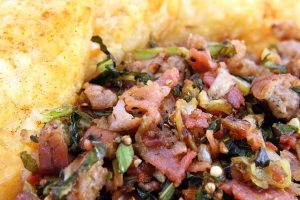Additives make food attractive, by sight and taste alike. But are they as safe as they look? This is what you should ask yourself the moment you think of buying packed food with all the additives running down the ingredients’ list. Some additives can have adverse effects on your health, and you should avoid them whenever possible.
High-Fructose Corn Syrup (HFCS)
HFCS is an inexpensive substitute for real sugar and is used primarily to sweeten beverages, including soft drinks. The American Heart Association identifies sugar-sweetened beverages as the main source of added sugars in our diet, suggesting that liquid calories are more likely to lead to weight gain than calories obtained from solid foods.
 Trans Fats
Trans Fats
Vegetable oils are hydrogenated to transform them from a liquid to a solid fat, which is done to create a desired consistency and to increase the shelf life of foods. Trans fats raise your triglyceride and low density lipoprotein (LDL, the bad cholesterol) levels, which not only increases your risk of heart attack, but has been linked to prostate cancer, breast cancer, Alzheimer’s disease, diabetes and obesity.
Monosodium Glutamate (MSG)
Monosodium glutamate, or MSG, is an artificial flavor found in thousands of processed foods, from fast food, to chips, to soup. While the FDA has classified MSG as “generally recognized as safe,” there have been numerous consumer complaints related to adverse reactions to foods containing MSG, including swelling, facial numbness, heart palpitations, nausea and weakness.
Sourced from: http://naturallysavvy.com/eat/7-scary-food-additives-to-avoid
Many people just pick up items from the supermarket shelves, without even taking time to glance at the ingredients used in making the product. It is after consumption that many people get to suffer the effects of some inappropriate products they bought down the street. Just how adverse food additives can be? Well, here are some of their dark sides.
Colors and allergies
Sunset yellow FCF can have a similar effect. Some animal studies have indicated sunset yellow can cause tumors, but the results aren’t consistent with other studies on rats and mice.
Natural additives aren’t necessarily safer than artificial ones. The natural coloring annatto (160b), for example — typically found in margarine, Cheshire cheese, smoked fish and cakes — can cause allergic-type reactions in some people.
Colors and cancer
Tests have linked allura red AC (129) with cancer in mice, but evidence of harm isn’t consistent or substantial. Claims that brilliant blue FCF (133) is carcinogenic are largely unsubstantiated.
Artificial sweeteners and cancer
In the 1970s, several studies of rats that were fed very large amounts of saccharin (954) found its use was associated with a higher incidence of bladder cancer. Research in 2005 from the European Ramazzini Foundation (updated in 2007) found feeding rats aspartame (951) at simulated doses around levels considered safe for humans increased the rats’ risk of leukemia, lymphoma and breast cancer.
Sourced From: https://www.choice.com.au/food-and-drink/food-warnings-and-safety/food-additives/articles/food-additives-you-should-avoid
Food additives do not come without their benefits. Some additives have been found to be important and reliable not only for making food better, but can as well help in fighting cancer. This shows a possibility of positive change for people fighting cancer and for everyone as well.
Advocates of natural foods have long objected to the use of preservatives, but Dr. Andrew Dannenberg of Cornell Medical College found that the preservatives BHA and BHT “revved up” the gene for an enzyme that helps destroy carcinogens before they lead to tumors.
When the genes are cranked up, they produce more of the enzyme, providing better protection against cancer-causing substances in the environment, Dr. Dannenberg reported last month at the International Conference on Cancer Prevention at Rockefeller University in New York.
BHA and BHT are synthetic additives used as preservatives in cookies, crackers and a wide variety of other foods.
“They are amazing vegetables,” Dr. Dannenberg said. “They have an amazing array of anti-cancer compounds.”
His research shows that at least part of the effect of those compounds comes from energizing the same gene affected by BHA and BHT.
The gene produces an enzyme called UDP-glucuronosyltransferase, or UGT. The study found elevated levels of the enzyme in the liver, kidneys and small intestines of rats fed higher doses of BHA and BHT than are normally found in foods, Dr. Dannenberg said.
Sourced from: http://www.nytimes.com/1994/10/25/science/2-additives-for-foods-may-fight-cancers.html